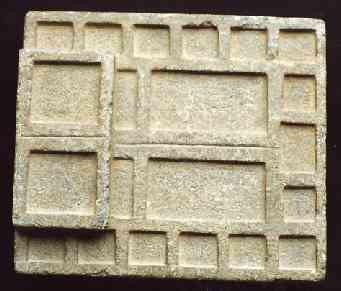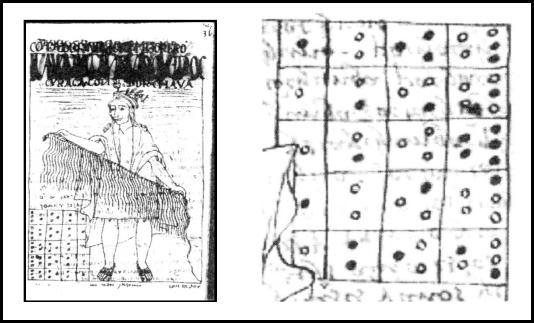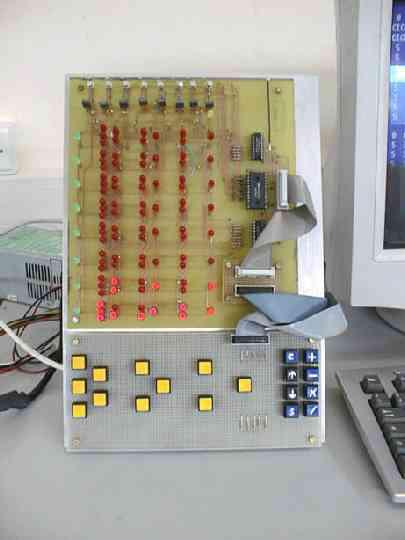It looks like you're using an Ad Blocker.
Please white-list or disable AboveTopSecret.com in your ad-blocking tool.
Thank you.
Some features of ATS will be disabled while you continue to use an ad-blocker.
2
share:
This is an aspect of the the Inca's culture that I believe haven't been covered here in ATS, (at least not found with search engine).

An intersting device used by the Incas, a counting board, also called "Peruvian Abacus". The yupana (quechua = counting tool), was used by the "Quipucamayos" (inca's accountants). It is difficult to define if this system was originally developed by the incas, in one of the links provided here, is a reference to a possible link with the tiawanaku culture.
In the Chronicle of Poma de Ayala, appears a drawn of a counter with their kipu and Yupana in the left corner below.
The chronicler doesn't give any details about how it was used or the specific structure of the board. See pic :

An spanish priest, José de Acosta, who lived with the Incas wrote in his book "Historia Natural Moral de las Indias", published in Madrid in 1596 :
The bolivian writer Javier Gacia Amaru, in his book "Dialectics Delusion", says :
The analysis made by this author is quiet complex and hard to translate to english for me, but I encourage to any member who knows spanish language to read it.

At this point of the thread, many of you probably are wondering how the yupana works. It is so incredibly easy that will give you an idea how ignorant were the spaniards to not understand it.
Here is a video made by peruvian school students, using a modern version of a yupana. The audio is in spanish of course, but really easy to understand if you follow the hands of the kids. Basically, what you can see is everytime one color completes the ten units, it gets empty and one unit is added to the next position in the left. Remember this example is based in 4 colors (4 digits numbers), but it can be expandable to more digits.
The first operation they do is 593+724. The second is 497-329.
The Italian mathematician, Nicolino De Pasquale, has proposed a new reading of the yupana and built a calculating machine, sort of an electronic yupana.

Links :
English :
www.quipus.it...
www.gap-system.org...
en.wikipedia.org...
Spanish :
www.enigmasperu.org...
www.amigo-latino.de...
matematicaandina.wordpress.com...

An intersting device used by the Incas, a counting board, also called "Peruvian Abacus". The yupana (quechua = counting tool), was used by the "Quipucamayos" (inca's accountants). It is difficult to define if this system was originally developed by the incas, in one of the links provided here, is a reference to a possible link with the tiawanaku culture.
In the Chronicle of Poma de Ayala, appears a drawn of a counter with their kipu and Yupana in the left corner below.
The chronicler doesn't give any details about how it was used or the specific structure of the board. See pic :

An spanish priest, José de Acosta, who lived with the Incas wrote in his book "Historia Natural Moral de las Indias", published in Madrid in 1596 :
To see them use another kind of calculator, with maize kernels, is a perfect joy. In order to carry out a very difficult computation for which would require pen and paper, these Indians make use of their kernels. They place one here, three somewhere else and eight, I know not where. They move one kernel here and there and the fact is that they are able to complete their computation without making the smallest mistake. as a matter of fact, they are better at practical arithmetic than we are with pen and ink. Whether this is not ingenious and whether these people are wild animals let those judge who will! What I consider as certain is that in what they undertake to do they are superior to us.
The bolivian writer Javier Gacia Amaru, in his book "Dialectics Delusion", says :
The two-dimensional thinking is characteristic of Western civilization. And the four-dimensional reasoning characterized the Hispanic ancestral wisdom.
The analysis made by this author is quiet complex and hard to translate to english for me, but I encourage to any member who knows spanish language to read it.
The Magic Square of Tiwanaku, which numbers added coefficients are equal to 9 and it manifest the tetraelectic codes of the 3 +1 asymmetry and 2 +2 symmetry (three pairs and a single non-divisible divisible pair 6 and 3, four and four odd even numbers).

At this point of the thread, many of you probably are wondering how the yupana works. It is so incredibly easy that will give you an idea how ignorant were the spaniards to not understand it.
Here is a video made by peruvian school students, using a modern version of a yupana. The audio is in spanish of course, but really easy to understand if you follow the hands of the kids. Basically, what you can see is everytime one color completes the ten units, it gets empty and one unit is added to the next position in the left. Remember this example is based in 4 colors (4 digits numbers), but it can be expandable to more digits.
The first operation they do is 593+724. The second is 497-329.
The Italian mathematician, Nicolino De Pasquale, has proposed a new reading of the yupana and built a calculating machine, sort of an electronic yupana.

According to the model by De Pasquale, in the yupana of the Nueva Corònica, the first numbers of
Fibonacci’s series (which the Incas had probably discovered before the influence of the after-
Conquest) were given a position value in a sort of abacus where the first 39 numbers were placed in
the lowest row, the numbers from 40 to 1560 in the above row and so on.
The resulting system is a base 40 one presenting the following values: 400, 401, 402,403, 404, in the
right column. (In the field of ethnography, the importance of number 40 in the Andean world,
Links :
English :
www.quipus.it...
www.gap-system.org...
en.wikipedia.org...
Spanish :
www.enigmasperu.org...
www.amigo-latino.de...
matematicaandina.wordpress.com...
edit on 8-12-2011 by Trueman because: (no reason given)
That's pretty interesting. I really like the way that it works.
I'm going to make my own board and do some practicing.
I'm going to make my own board and do some practicing.
That's pretty interesting. I really like the way that it works.
I'm going to make my own board and do some practicing.
I'm going to make my own board and do some practicing.
reply to post by isyeye
Good idea, also I think it can be a great way to teach math to little kids, don't you think?
Good idea, also I think it can be a great way to teach math to little kids, don't you think?
reply to post by Trueman
Actually, I think what I'm going to do is try to make a 3-d set of boards for calculating large numbers. It's a good theory about how to track numbers and might be interesting to see it work on a larger scale. Maybe use different size markers for tracking numbers in larger units of 10's, 100's, 1000's, etc...
Actually, I think what I'm going to do is try to make a 3-d set of boards for calculating large numbers. It's a good theory about how to track numbers and might be interesting to see it work on a larger scale. Maybe use different size markers for tracking numbers in larger units of 10's, 100's, 1000's, etc...
new topics
-
Anybody else using Pomodoro time management technique?
General Chit Chat: 2 hours ago -
Bucks County commissioners vote to count illegal ballots in Pennsylvania recount
2024 Elections: 4 hours ago -
Trump sues media outlets -- 10 Billion Dollar lawsuit
US Political Madness: 5 hours ago -
Fired fema employee speaks.
US Political Madness: 5 hours ago -
How long till it starts
US Political Madness: 7 hours ago -
USSS Agent Fired for Having Sex In Michelle Obama's Bathroom
Politicians & People: 8 hours ago -
Watching TV
Jokes, Puns, & Pranks: 11 hours ago
top topics
-
Trump sues media outlets -- 10 Billion Dollar lawsuit
US Political Madness: 5 hours ago, 20 flags -
Bucks County commissioners vote to count illegal ballots in Pennsylvania recount
2024 Elections: 4 hours ago, 17 flags -
How long till it starts
US Political Madness: 7 hours ago, 15 flags -
USSS Agent Fired for Having Sex In Michelle Obama's Bathroom
Politicians & People: 8 hours ago, 9 flags -
Fired fema employee speaks.
US Political Madness: 5 hours ago, 9 flags -
Watching TV
Jokes, Puns, & Pranks: 11 hours ago, 7 flags -
Anybody else using Pomodoro time management technique?
General Chit Chat: 2 hours ago, 2 flags
active topics
-
Qatar kicks out HAMAS
Middle East Issues • 21 • : jofafot -
Bucks County commissioners vote to count illegal ballots in Pennsylvania recount
2024 Elections • 11 • : WeMustCare -
WATCH LIVE: US Congress hearing on UFOs, unidentified anomalous phenomena
Aliens and UFOs • 79 • : NoCorruptionAllowed -
How long till it starts
US Political Madness • 7 • : WeMustCare -
The Guardian quits Elon Musk's X social media platform
Mainstream News • 17 • : JadedGhost -
Trump sues media outlets -- 10 Billion Dollar lawsuit
US Political Madness • 27 • : WeMustCare -
Turns out, they planned to go after P-nut.
US Political Madness • 40 • : Oldcarpy2 -
The Trump effect 6 days after 2024 election
2024 Elections • 127 • : Astrocometus -
The Acronym Game .. Pt.4
General Chit Chat • 958 • : Encia22 -
Post A Funny (T&C Friendly) Pic Part IV: The LOL awakens!
General Chit Chat • 7775 • : underpass61
2
